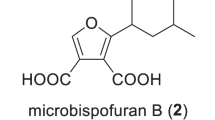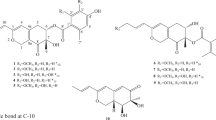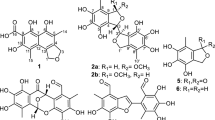Abstract
Two new chloropyrroles, designated catellatopyrroles A (1) and B (2), along with 2-(2′-hydroxybenzoyl)pyrrole (3), were isolated from a culture extract of an actinomycete of the genus Catellatospora. The structures of 1–3 were elucidated through interpretation of NMR and MS data. Compounds 1 and 2 are the first chloropyrroles substituted by an aliphatic acyl group at the 5-position. Compounds 1–3 promoted root elongation of germinated lettuce seeds at 1–10 μM. While all compounds inhibited the growth of Gram-positive bacteria, activity against Gram-negative bacterium Rhizobium radiobacter and yeasts Candida albicans and Saccharomyces cerevisiae was varied. Compounds 1 and 2 were moderately cytotoxic against P388 cells.
This is a preview of subscription content, access via your institution
Access options
Subscribe to this journal
Receive 12 print issues and online access
$259.00 per year
only $21.58 per issue
Buy this article
- Purchase on Springer Link
- Instant access to full article PDF
Prices may be subject to local taxes which are calculated during checkout







Similar content being viewed by others
References
Dashti Y, Grkovic T, Abdelmohsen UR, Hentschel U, Quinn RJ. Actinomycete metabolome induction/suppression with N-acetylglucosamine. J Nat Prod. 2017;80:828–36.
Kontou EE, et al. Discovery and characterization of epemicins A and B, new 30-membered macrolides from Kutzneria sp. CA-103260. ACS Chem Biol. 2021;16:1456–68.
Son S, et al. Catenulisporolides, glycosylated triene macrolides from the chemically underexploited actinomycete Catenulispora species. Org Lett. 2018;20:7234–8.
Saito S, Indo K, Oku N, Komaki H, Kawasaki M, Igarashi Y. Unsaturated fatty acids and a prenylated tryptophan derivative from a rare actinomycete of the genus Couchioplanes. Beilstein J Org Chem. 2021;17:2939–49.
Saito S, et al. A cyclopeptide and three oligomycin-class polyketides produced by an underexplored actinomycete of the genus Pseudosporangium. Beilstein J Org Chem. 2020;16:1100–10.
Saito S, Oku N, Igarashi Y. Mycetoindole, an N-acyl dehydrotryptophan with plant growth inhibitory activity from an actinomycete of the genus Actinomycetospora. J Antibiot. 2022;75:44–7.
Asano K, Kawamoto I. Catellatospora, a new genus of the actinomycetales. Int J Syst Bacteriol. 1986;36:512–7.
Meier-Kolthoff JP, Sardà Carbasse J, Peinado-Olarte RL, Göker M. TYGS and LPSN: a database tandem for fast and reliable genome-based classification and nomenclature of prokaryotes. Nucleic Acids Res. 2022;50:D801–7.
AntiSMASH. The AntiSMASH project. https://antismash.secondarymetabolites.org. Accessed 2021-12-27.
Kurabachew M, et al. Lipiarmycin targets RNA polymerase and has good activity against multidrug-resistant strains of Mycobacterium tuberculosis. J Antimicrob Chemother. 2008;62:713–9.
Liu C, et al. Catellatolactams A–C, plant growth-promoting ansamacrolactams from a rare actinomycete of the genus Catellatospora. J Nat Prod. 2022;85:1993–9.
Petruso S, Bonanno S, Caronna S, Ciofalo M, Maggio B, Schillaci D. Oxidative halogenation of substituted pyrroles with Cu (II). Part IV. Bromination of 2‐(2′‐hydroxybenzoyl) pyrrole. A new synthesis of bioactive analogs of monodeoxypyoluteorin. J Heterocycl Chem. 1994;31:941–5.
Kikuchi H, et al. Revised structure and synthesis of celastramycin A, a potent innate immune suppressor. Org Lett. 2009;11:1693–5.
Durán-Sampedro G, et al. Chlorinated BODIPYs: surprisingly efficient and highly photostable laser dyes. Eur J Org Chem. 2012;32:6335–50.
Takahashi N, (ed.). Shokubutsu-kagaku-chosetsu-jikkenho (Experimental protocols for chemical regulation of plants). Tokyo: The Japanese Society for Chemical Regulation of Plants; 1989. p. 140–1 (in Japanese).
Ahmed FR, Toube TP. Incorporation of carbon-14 in the biosynthesis of the macrolide antibiotic, IL-F28249-.ALPHA. J Antibiot. 1993;46:888–91.
Yamagishi Y, Shindo K, Kawai H. Rumbrin, a new cytoprotective substance produced by Auxarthron umbrinum. II. Physico-chemical properties and structure determination. J Antibiot. 1993;46:888–91.
Hosoe T, Fukushima K, Takizawa K, Miyaji M, Kawai K. Three pyrrolyloctatetraenyl-α-pyrones from Auxarthron conjugatum. Phytochemistry. 1999;52:459–63.
Clark BR, Capon RJ, Lacey E, Tennant S, Gill JH. Polyenylpyrroles and polyenylfurans from an Australian isolate of the soil ascomycete Gymnoascus reessii. Org Lett. 2006;8:701–4.
Rudi A, et al. Phorbazoles A–D, novel chlorinated phenylpyrrolyloxazoles from the marine sponge Phorbas aff. clathrata. Tetrahedron Lett. 1994;35:2589–92.
Laird DW, LaBarbera DV, Feng X, Bugni TS, Harper MK, Ireland CM. Halogenated cyclic peptides isolated from the sponge Corticium sp. J Nat Prod. 2007;70:741–6.
Nuzzo G, Ciavatta ML, Kiss R, Mathieu V, Leclercqz H, Manzo E, Villani G, Mollo E, Lefranc F, D’Souza L, Gavagnin M, Cimino G. Chemistry of the nudibranch Aldisa andersoni: structure and biological activity of phorbazole metabolites. Mar Drugs. 2012;10:1799–811.
Qiao Y, et al. Characterization of the biosynthetic gene cluster for the antibiotic armeniaspirols in Streptomyces armeniacus. J Nat Prod. 2019;82:318–23.
Schnegotzki R, et al. Total synthesis and biosynthesis of cyclodepsipeptide cochinmicin I. Org Lett. 2022;24:2344–8.
Heide L. The aminocoumarins: biosynthesis and biology. Nat Prod Rep. 2009;26:1241–50.
van Pée K-H, Ligon JM. Biosynthesis of pyrrolnitrin and other phenylpyrrole derivatives by bacteria (up to mid-1999). Nat Prod Rep. 2000;17:157–64.
Takeda R. Pseudomonas pigments. I. Pyoluteorin, a new chlorine-containing pigment produced by Pseudomonas aeruginosa. Hakko Kogaku Zasshi. 1958;36:281–6.
Howell CR. Suppression of Pythium ultimum-induced damping-off of cotton seedlings by Pseudomonas fluorescens and its antibiotic, pyoluteorin. Phytopathology. 1980;70:712–5.
Takeda R. Structure of a new antibiotic, pyoluteorin. J Am Chem Soc. 1958;80:4749–50.
Ezaki N, Koyama M, Shomura T, Tsuruoka T, Inouye S. Pyrrolomycins C, D and E, new members of pyrrolomycins. J Antibiot. 1983;36:1263–7.
Koyama M, Ezaki N, Tsuruoka T, Inouye S. Structural studies on pyrrolomycins C, D and E. J Antibiot. 1983;36:1483–9.
Hughes CC, Kauffman CA, Jensen PR, Fenical W. Structures, reactivities, and antibiotic properties of the marinopyrroles A–F. J Org Chem. 2010;75:3240–50.
Shindo K, Yamagishi Y, Kawai H. Thiazohalostatin, a new cytoprotective substance produced by Actinomadura. II. Physico-chemical properties and structure determination. J Antibiot. 1996;46:1638–42.
Zhang Z, et al. Nomimicins B-D, new tetronate-class polyketides from a marine-derived actinomycete of the genus Actinomadura. Beilstein J Org Chem. 2021;17:2194–202.
Lu S, Harunari E, Oku N, Igarashi Y, Trehangelin E. a bisacyl trehalose with plant growth promoting activity from a rare actinomycete Polymorphospora sp. RD064483. J Antibiot. 2022;75:296–300.
Zhang Z, et al. Kumemicinones A–G, cytotoxic angucyclinones from a deep sea-derived actinomycete of the genus Actinomadura. J Nat Prod. 2022;85:1098–108.
Igarashi Y, et al. Nonthmicin, a polyether polyketide bearing a halogen-modified tetronate with neuroprotective and antiinvasive activity from Actinomadura sp. Org Lett. 2017;19:1406–9.
Yamamura H, Hayakawa M, Iimura Y. Application of sucrose-gradient centrifugation for selective isolation of Nocardia spp. from soil. J Appl Microbiol. 2003;95:677–85.
Yoon SH, et al. Introducing EzBioCloud: a taxonomically united database of 16S rRNA gene sequences and whole-genome assemblies. Int J Syst Evol Microbiol. 2017;67:1613–7.
Kumar S, Stecher G, Li M, Knyaz C, Tamura K. Molecular evolutionary genetics analysis across computing platforms. Mol Biol Evol. 2018;35:1547–9.
Hayakawa M, Nonomura H. Humic acid-vitamin agar, a new medium for the selective isolation of soil actinomycetes. J Ferment Technol. 1987;65:501–9.
Karim MRU, Harunari E, Oku N, Akasaka K, Igarashi Y, Bulbimidazoles A–C. antimicrobial and cytotoxic alkanoyl imidazoles from a marine gammaproteobacterium Microbulbifer species. J Nat Prod. 2020;83:1295–9.
Sharma AR, Zhou T, Harunari E, Oku N, Trianto A, Igarashi Y. Labrenzbactin from a coral-associated bacterium Labrenzia sp. J Antibiot. 2019;72:634–9.
Acknowledgements
We thank Mr. Masaru Watanabe at Yamanashi University for SEM sample preparation. P388 cells were obtained from JCRB Cell Bank under an accession code JCRB0017 (Lot. 06252002). This work was supported by JSPS KAKENHI Grant Number 19K05848 to YI.
Author information
Authors and Affiliations
Corresponding author
Ethics declarations
Conflict of interest
The authors declare no competing interests.
Additional information
Publisher’s note Springer Nature remains neutral with regard to jurisdictional claims in published maps and institutional affiliations.
Rights and permissions
Springer Nature or its licensor holds exclusive rights to this article under a publishing agreement with the author(s) or other rightsholder(s); author self-archiving of the accepted manuscript version of this article is solely governed by the terms of such publishing agreement and applicable law.
About this article
Cite this article
Liu, C., Yamamura, H., Hayakawa, M. et al. Plant growth-promoting and antimicrobial chloropyrroles from a rare actinomycete of the genus Catellatospora. J Antibiot 75, 655–661 (2022). https://doi.org/10.1038/s41429-022-00567-x
Received:
Revised:
Accepted:
Published:
Issue Date:
DOI: https://doi.org/10.1038/s41429-022-00567-x
This article is cited by
-
Development of a drug discovery approach from microbes with a special focus on isolation sources and taxonomy
The Journal of Antibiotics (2023)
-
Isolation and structure determination of allopteridic acids A–C and allokutzmicin from an unexplored actinomycete of the genus Allokutzneria
The Journal of Antibiotics (2023)



